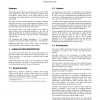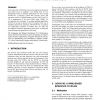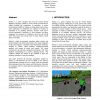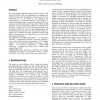VRML
1998
ACM
14 years 3 months ago
1998
ACM
This paper discusses the history and design decisions behind OpenWorlds, the first C++ toolkit for VRML 2.0 integration. OpenWorlds is a highly extensible set of libraries which s...
VRML
1998
ACM
14 years 3 months ago
1998
ACM
While many pleasing effects are possible using the current VRML sound model [9], it falls short of producing convincing aural environments. Sound sources are not easily affected b...
VRML
1998
ACM
14 years 3 months ago
1998
ACM
In its current state, VRML does not provide support for interaction and on-line access to databases, even though these are two fundamental issues for business applications. We hav...
VRML
1998
ACM
14 years 3 months ago
1998
ACM
VRML
1998
ACM
14 years 3 months ago
1998
ACM
Peloton is a sports simulator that uses the Virtual Reality Modeling Language (VRML) to create virtual environments for athletic training and competition. In particular, it create...
VRML
1998
ACM
14 years 3 months ago
1998
ACM
The Virtual Reality Modeling Language (VRML) and the World Wide Web (WWW) offer new opportunities to communicate an architect’s design intent throughout the design process. We h...
VRML
1998
ACM
14 years 3 months ago
1998
ACM
VRML (the Virtual Reality Modeling Language) has brought 3D objects and virtual worlds to a large number of Internet users. While it provides a suitable basis for the platform ind...
VRML
1998
ACM
14 years 3 months ago
1998
ACM
VRML offers a high potential for product presentation: Instead of regarding flat, static pictures, configurable and animated 3D models embedded in entertaining environments provid...
VRML
1998
ACM
14 years 3 months ago
1998
ACM
We present a new method for (1) automatically generating multiple Levels Of Detail (LODs) of a polygonal surface, (2) progressively loading, or transmitting, and displaying a surf...
VRML
1998
ACM
14 years 3 months ago
1998
ACM
This paper describes an application of VRML-based multimedia to the domain of spatial cognition experiments. Typically, such experiments involve human subjects that are presented ...




